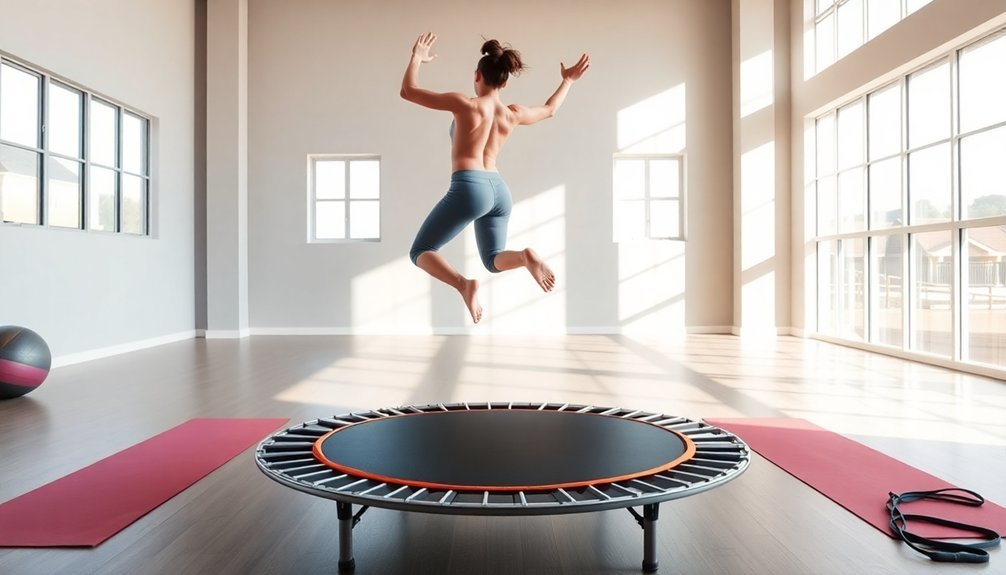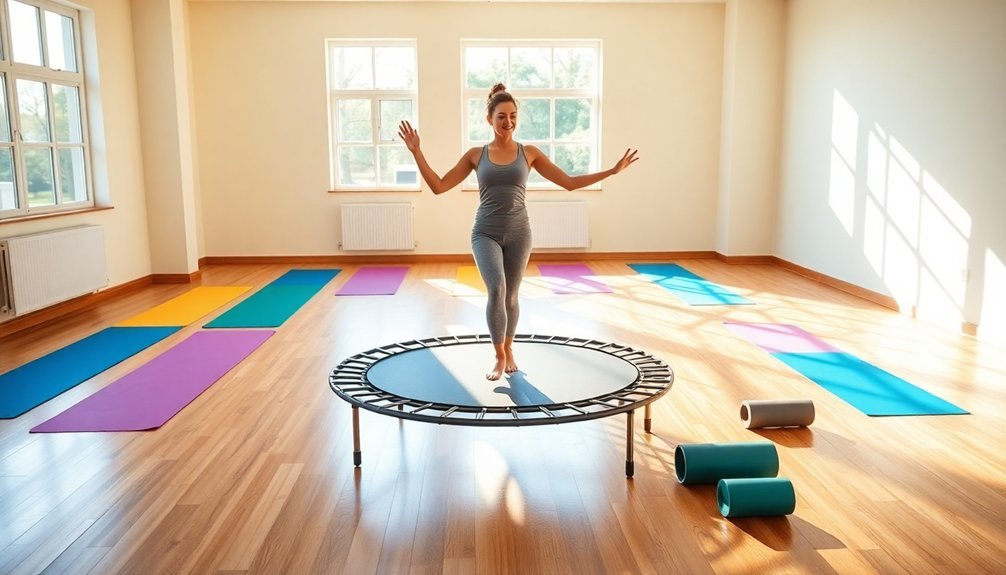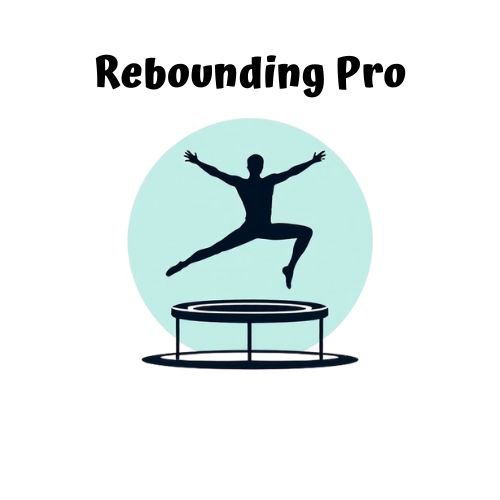Trampoline workouts can greatly reduce back pain by offering low-impact exercise that strengthens core muscles while minimizing joint stress. Try gentle bounces, knee lifts, air bikes, seated bounces, and light twists to build spinal support. Adding hamstring stretches, cat-cow poses, and surf twists provides thorough relief. Start with just 5-10 minutes daily, gradually increasing to 20-minute sessions 3-4 times weekly. Proper form with engaged core is essential for these gentle yet effective movements that can transform your spinal health.
Understanding How Trampoline Workouts Benefit Your Spine

While traditional exercise might put strain on your back, trampoline workouts offer a gentler alternative that can actually improve spine health. The trampoline's springs absorb about 80% of the impact, making it easier on your joints and spine than high-impact activities like running.
When you bounce, you're strengthening your back muscles while improving flexibility without damaging your spine. This gentle, repetitive motion helps soften and restore elasticity to the cartilage between vertebrae, enhancing your spinal mobility and range of motion.
Orthopedic surgeons often recommend trampoline exercise as a low-impact method for improving back health. Using bungee cords instead of springs provides an even smoother experience that further protects your spine.
The constant adjustments your body makes while bouncing also enhance your balance and coordination, which are essential for maintaining proper posture and reducing spine strain.
The Science Behind Rebounding for Back Pain Relief
Your spine experiences constant compression from gravity, but rebounding counters this effect by creating moments of weightlessness followed by gentle gravitational pull.
The up-and-down motion of trampoline exercise stimulates your lymphatic system, which helps remove inflammatory waste that can contribute to back pain. This gentle movement conditions the small support muscles that often become weak with disuse and contribute to common back strains.
Unlike high-impact activities that compress your vertebrae, rebounding allows you to strengthen back muscles and improve spinal flexibility with up to 80% less joint stress.
Gravity's Impact on Spines
When you stand upright, Earth's gravity constantly pulls down on your body, creating a compression force that considerably impacts your spine. This pressure compresses your intervertebral discs, causing them to lose water throughout the day—which is why you're actually shorter at night than in the morning.
Your body's response to gravity isn't all negative. These forces strengthen the muscles supporting your spine, providing vital stability. However, chronic compression can contribute to back pain and disc degeneration over time.
Interestingly, in microgravity environments, astronauts' spines elongate and discs expand, often causing discomfort. Astronauts typically experience up to two inches of increased height during space missions due to this spinal elongation. This illustrates why balanced gravitational input is essential for spinal health.
Rebounding exercises provide this balance perfectly, offering gentle compression and decompression cycles that strengthen supporting muscles while reducing harmful impact.
Lymphatic System Benefits
The lymphatic system serves as your body's natural detoxification network, playing an essential role in back pain management when properly stimulated.
Unlike your cardiovascular system, lymph fluid lacks a central pump, relying instead on muscle contractions and movement to flow properly.
Rebounding creates the perfect conditions for lymphatic circulation through gentle bouncing that activates the system's one-way valves. This rhythmic movement can increase lymph flow up to 15 times normal rates, efficiently removing inflammatory toxins that may contribute to back pain.
Studies, including NASA research, have found rebounding to be 68% more oxygen-efficient than conventional exercise while remaining gentle on joints.
You'll experience reduced inflammation and improved cellular waste removal with consistent trampoline exercise, creating an internal environment that supports back healing. For maximum effectiveness, beginners should follow a structured approach of two 5-minute sessions daily before gradually increasing duration.
Rebounding Versus Compression
Understanding the science behind rebounding reveals why it's particularly effective for back pain sufferers.
While traditional exercises create compressive forces on your spine and joints, rebounding works differently. On a trampoline, the spring-loaded surface absorbs much of the impact that would normally stress your back. This creates a unique low-impact environment where you can exercise vigorously without the harmful compression.
Your spine experiences gentle stretching and compression cycles that actually promote disc health and flexibility. The biomechanical advantage becomes clear when you compare rebounding to running or jogging.
Your joints and vertebrae aren't subjected to the same jarring forces. Instead, you'll engage your muscles dynamically, strengthening the supportive structures around your spine while minimizing stress on already sensitive areas. Regular jumping contracts and strengthens your spinal muscles, providing enhanced stability for your lower back over time.
Getting Started: Equipment and Safety Essentials
To begin your back-relief journey on a mini trampoline, you'll need a model with sturdy construction, stable arched legs, and preferably a bungee system for gentler landings.
Invest in non-slip gripper socks and consider trampolines with handles to maximize your stability and prevent falls during workouts.
You'll also need to set up your trampoline in a space with at least 2-3 feet of clearance on all sides and adequate ceiling height to accommodate your bouncing movements. This equipment setup helps create low impact exercise conditions that are known to reduce chronic low back pain while protecting your joints.
Mini Trampoline Features
Selecting an appropriate mini trampoline represents your first step toward effective low-impact workouts for back pain relief. Most models come in 39 or 44-inch diameters, making them perfect for apartments or small exercise spaces.
Look for a trampoline with sturdy springs that absorb shock effectively, reducing impact on your spine and joints. Many quality options include stability bars which provide essential support as you regain balance and confidence during your routine.
The lightweight, portable design means you can easily move your trampoline between rooms or take it outdoors when weather permits. For back pain sufferers, this versatility is invaluable.
Mini trampolines are particularly beneficial because they are easier on joints compared to traditional exercises like running on pavement or treadmills.
Before purchasing, verify the model can support your weight comfortably and features a durable, taut jumping surface that delivers consistent rebounding action with each movement.
Supportive Gear Essentials
Beyond the trampoline itself, four key pieces of equipment enhance both safety and effectiveness for back pain sufferers.
Gripper socks provide essential stability with their non-slip bottoms, preventing dangerous slips while bouncing.
For beginners or those with significant mobility concerns, mini trampolines with handlebars offer vital additional support.
Safety nets or rails aren't just for children—they're valuable safeguards for adults managing back pain, preventing falls that could worsen your condition.
Wear loose, comfortable clothing that won't restrict your movement or breathing during exercise.
Remember that equipment maintenance matters too.
Regularly inspect your trampoline for wear and tear, especially on the mat and springs or bungees.
Bungee-based trampolines typically offer gentler bounces than spring models, making them preferable for those with back sensitivity.
Consider investing in quality rebounders like The Ness trampoline which features arched legs and a buoyant mat for optimal stability and comfort while exercising.
Proper Setup Space
Creating a proper setup space for your mini trampoline is crucial for maximizing both safety and back pain relief benefits.
Position your trampoline on a completely flat surface with at least two feet of clearance on all sides to prevent accidents during workouts.
Measure your available area before purchasing—consider models between 36-40 inches for tight spaces or 44-48 inches if you need more bouncing surface.
Keep the trampoline away from furniture and sharp objects that could cause injury if you lose balance.
For small spaces, look for foldable designs that can be easily stored when not in use.
Always check the floor's stability and consider using protective mats underneath if needed.
Regular inspection of your setup guarantees your equipment remains safe and effective for back pain management.
For rehabilitation purposes focused on alleviating back pain, a 36-40 inch rebounder is typically recommended as it provides adequate stability while allowing for controlled movements.
Gentle Warm-Up Bounces to Prepare Your Back
Before diving into a full trampoline workout, you'll need to properly prepare your back with gentle warm-up bounces that gradually activate your muscles and spine.
Start with a few minutes of low-impact movements to get your blood flowing without stressing your joints.
Begin with gentle, low-impact movements that stimulate circulation while protecting your joints from unnecessary stress.
- Try marching in place, keeping your feet in contact with the trampoline surface while lifting your knees alternately.
- Perform gentle knee lifts with slight bounces to prepare your lower body for more intense activity.
- Practice basic bouncing with feet together or slightly apart to engage your core and gently mobilize your spine.
- Add arm movements and light rotations to improve upper body flexibility while maintaining a controlled bounce.
These warm-up exercises help enhance lymphatic function, reduce inflammation, and gradually strengthen back muscles. Incorporating soft knee bends while standing on the trampoline can further reduce impact and help protect your back during the initial warm-up phase.
Core-Strengthening Trampoline Exercises for Spinal Support

A strong core forms the foundation of a healthy back, making it central to any effective low-impact trampoline routine. By engaging your deep abdominal muscles, you'll create natural support for your spine while bouncing.
Start with gentle twists to activate your obliques—simply bounce lightly while rotating your upper body. Progress to knee pulls by bringing your knees toward your chest during small bounces.
For the air bike exercise, lie on your back on the trampoline and pedal your legs while engaging your core.
When performing these exercises, maintain proper form by keeping your core engaged throughout. If you're new to trampoline workouts or have existing back issues, use handlebars for stability and always start slowly.
Remember to get your doctor's approval before beginning this regimen. These exercises offer a low-impact cardio option while being gentle on joints, making them ideal for those with back pain.
Lower Back Relief Routines on the Mini-Trampoline
While many exercises can strain your lower back, mini-trampoline workouts offer a gentle yet effective path to relief. The rebounding motion strengthens back muscles while minimizing joint impact, creating an ideal environment for healing and prevention. Focus on maintaining a neutral spine while performing any rebounding exercises to maximize back protection.
For best lower back relief, try these targeted routines:
- Gentle Bounce Progression – Start with light bouncing for 1-2 minutes, gradually increasing as your back muscles adapt.
- Core-Engaged Health Bounce – Maintain slight core tension while performing small, controlled bounces.
- Alternating Knee Lifts – Slowly lift each knee while maintaining balance to release tension.
- Surf Twist Series – With feet planted, perform gentle hip rotations to improve spinal mobility.
Always wear proper footwear and consider using a handlebar for added stability, especially when beginning your rebounding journey.
Progressive Rebounding Techniques for Chronic Back Pain

Living with chronic back pain requires a careful approach to exercise, and progressive rebounding offers an effective solution for many sufferers. This low-impact activity reduces spine stress while strengthening core and back muscles essential for stability.
Start with gentle bouncing and gradually increase intensity as your body adapts. You'll want to focus on proper technique to prevent strain. Consider incorporating resistance bands later to enhance your workout's effectiveness. For effective recovery, maintain proper form to avoid injury while performing progressive exercises on the trampoline.
Before beginning, consult your healthcare provider to verify rebounding is appropriate for your condition. Choose quality equipment designed specifically for therapeutic use and maintain it regularly.
For maximum benefit, combine your trampoline routine with other therapies like massage or heat treatment. This integrated approach addresses multiple aspects of back pain while improving circulation and flexibility.
Combining Stretching With Rebounding for Maximum Relief
Combining stretching with rebounding creates a powerful synergy that can dramatically amplify your back pain relief.
This integrated approach addresses both flexibility and strength simultaneously, delivering extensive benefits that neither technique can achieve alone. You'll experience faster recovery and more sustainable results when you incorporate both practices into your routine. Regular exercise builds strength and reduces pain while promoting better spinal health through diverse movements.
- Start with 5-10 minutes of gentle stretching to prepare your muscles before stepping onto the trampoline.
- Alternate between 2-minute rebounding sessions and targeted back stretches for ideal relief.
- Focus on posterior chain stretches (hamstrings, glutes, lower back) to complement the strengthening effects of rebounding.
- End your workout with deep, sustained stretches to lock in the benefits and reduce post-exercise stiffness.
Creating Your 20-Minute Daily Back Pain Relief Routine
Start your trampoline workout journey with gentle bounces before adding more complex movements to your routine.
Your warm-up isn't optional—it prepares your muscles and spine for activity while reducing injury risk. Incorporate cat-cow stretches and child's pose to promote spinal flexibility and decompress your back before rebounding.
Balance your rebounding sessions with rest days to give your back adequate recovery time, especially when you're just beginning.
Start Slow, Progress Gradually
When beginning a trampoline routine for back pain relief, it's crucial to ease into the practice rather than jumping straight into complex movements. Start with basic bounces for 5-10 minutes to familiarize yourself with the trampoline's feel and develop your balance.
As your confidence builds, gradually increase your workout duration to 16-minute sessions, which you can eventually repeat for a full 32-minute workout. Regular participation in these sessions will release natural painkillers that can significantly reduce your perception of back pain.
Remember to:
- Keep your core engaged throughout all movements to protect your spine
- Incorporate gentle side-to-side and forward-backward movements to improve mobility
- Add arm movements only after mastering lower body stability
- Always end with targeted stretches that support back flexibility
Monitor how your body responds and adjust your intensity accordingly. Progress is more important than perfection.
Warm-Up Is Essential
A proper warm-up serves as the foundation for any effective trampoline workout, especially when you're managing back pain.
Begin with basic balance exercises, focusing on your posture while engaging your core muscles. Add gentle ankle rolls in both directions to prepare your lower extremities.
Incorporate side steps to loosen your hip joints before shifting to gentle bouncing. This gradual introduction helps your body adjust to the trampoline's unique surface. Starting with short sessions of 5-10 minutes allows your body to gradually adapt to rebounding exercise without straining your back.
Include walking in place or controlled lunges to enhance stability.
Throughout your warm-up, maintain proper form by engaging your abdominals, keeping your spine neutral, and relaxing your shoulders.
Practice deep breathing to center yourself and reduce tension.
This 3-5 minute investment prevents injury and optimizes your workout's effectiveness, particularly for those with sensitive backs.
Balance Rest With Activity
Creating an effective trampoline routine for back pain relief requires balancing activity with adequate rest periods. Aim for 15-20 minute sessions 3-4 times weekly to strengthen core muscles without overexertion.
Listen to your body and adjust workout duration accordingly to prevent strain on your back. The low-impact nature of rebounding makes it ideal for those with back pain as it minimizes stress on the spine while providing effective exercise. Include rest days between sessions to allow muscles to recover properly. This balance helps maintain consistency while supporting your spine's health.
Combine rebounding with complementary therapies like yoga for extensive benefits.
- Start with gentle bouncing for 5 minutes to warm up back muscles
- Incorporate various movements like rhythm walks and light twists to engage different muscle groups
- Schedule dedicated recovery days between workouts
- Consult with healthcare professionals to customize your routine based on your specific back condition
Tracking Your Progress: What Improvements to Expect
Starting on a low-impact trampoline journey requires patience and attention to how your body responds over time.
You'll likely notice enhanced back muscle strength and flexibility within weeks, leading to improved posture and reduced inflammation.
Tracking your progress can be done through various methods.
Consider using heart rate monitors to measure cardiovascular improvements or maintaining a workout journal to document pain levels and exercise frequency.
Taking progress photos and scheduling regular medical check-ups will help validate your improvements objectively.
As you continue your rebounding routine, expect gradual relief from chronic back pain, increased mobility, and a stronger core.
The lymphatic benefits and reduced muscle tension contribute to overall wellness.
Even short 15-20 minute sessions can yield significant improvements in your back health over time. For beginners or those with severe back issues, consider starting with the stability bar workouts which provide extra support while you build confidence.
Frequently Asked Questions
Can Trampoline Workouts Worsen Herniated Discs?
Yes, trampoline workouts can worsen herniated discs if you're doing high-impact bouncing or jumping. You'll need to avoid these movements and stick to gentle marching exercises instead for safety.
How Do Trampoline Exercises Compare to Inversion Therapy?
Unlike inversion therapy's focus on spinal decompression, you'll find trampolines offer broader benefits—strengthening muscles, improving balance, and enhancing cardiovascular health. They're also more cost-effective and accessible for most fitness levels.
Are Mini-Trampolines or Full-Size Models Better for Back Rehabilitation?
Mini-trampolines are better for back rehabilitation than full-size models. You'll benefit from their stability, lower injury risk, and convenient size. They're easier to control while still providing effective low-impact strengthening for your back muscles.
Can Seniors With Osteoporosis Safely Use Trampolines?
Yes, you can safely use trampolines with osteoporosis if you take precautions. Use mini-trampolines with handles, stick to gentle bouncing without lifting your feet, and always consult your doctor first.
How Soon After Back Surgery Can I Begin Trampoline Therapy?
You should wait until your doctor gives clearance, typically 3-6 months after back surgery. Start only after proper healing and follow a gradual approach with professional guidance for safety.
In Summary
You've now got ten effective ways to strengthen your back and ease pain through gentle rebounding. Start slow, stay consistent, and you'll likely notice improved mobility and decreased discomfort within weeks. Remember, your trampoline workout doesn't need to be intense to be effective. Listen to your body, adapt these exercises to your comfort level, and enjoy the bounce-based path to a healthier spine.





Leave a Reply